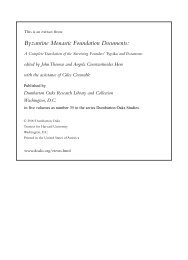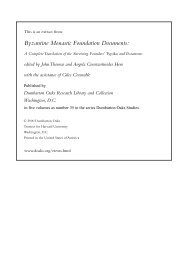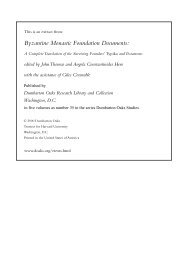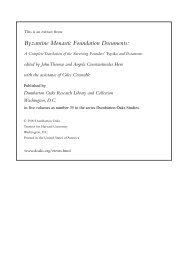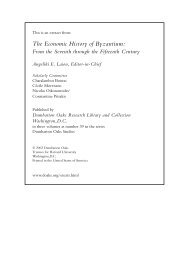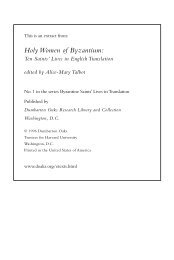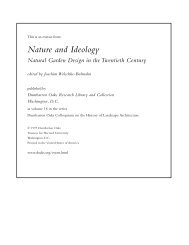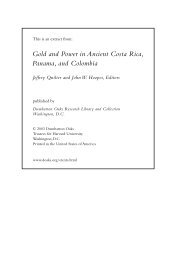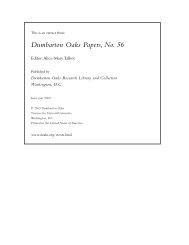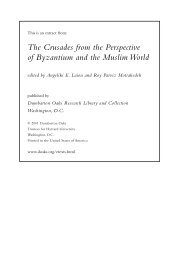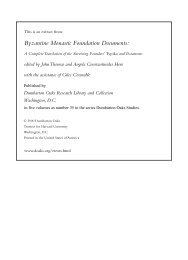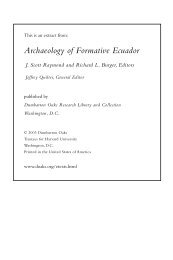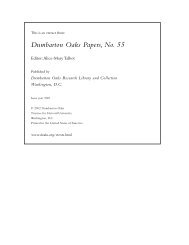28. Pantokrator - Dumbarton Oaks
28. Pantokrator - Dumbarton Oaks
28. Pantokrator - Dumbarton Oaks
Create successful ePaper yourself
Turn your PDF publications into a flip-book with our unique Google optimized e-Paper software.
<strong>28.</strong> PANTOKRATOR<br />
<strong>28.</strong> <strong>Pantokrator</strong>: Typikon of Emperor John II Komnenos for<br />
the Monastery of Christ <strong>Pantokrator</strong> in Constantinople<br />
Date: October 1136 Translator: Robert Jordan<br />
Edition employed: Paul Gautier, “Le typikon du Christ Sauveur Pantocrator,” REB 32 (1974),<br />
1–145, with text at 27–131.<br />
Manuscripts: Parisinus graecus 389, fols. 1–61 (before 1740); Codex 85, nunc 79, Theological<br />
School, Halki, now in the Patriarchal Library, Istanbul, fols. 69–122v (1749). 1<br />
Other translation: French, by Gautier, “Pantocrator,” pp. 26–130.<br />
Institutional History<br />
A. Description of the Foundation<br />
The monastery of Christ tou <strong>Pantokrator</strong>os “The Ruler of All” was built by Emperor John II<br />
Komnenos (1118–43) on a hill in the north central part of Constantinople. 2 In some sources the<br />
work is attributed to his spouse Irene, daughter of King Ladislas of Hungary. 3 The construction is<br />
attributed to an architect named Nikephoros. The foundation included a triple church, with discrete<br />
but physically joined facilities dedicated to Christ <strong>Pantokrator</strong> (south church), the Archangel<br />
Michael (central church), and the Mother of God Eleousa (north church). This structure survives<br />
as the mosque Zeyrek Kilise Camii in modern Istanbul. Archaeological evidence suggests<br />
that the <strong>Pantokrator</strong> was built first, followed by the Eleousa, and lastly by the Archangel Michael,<br />
which was designed to serve as an imperial mortuary chapel for the Komnenian dynasty. 4 There<br />
was also a famous hospital attached to the foundation as well as an old age home. A lepers’<br />
sanatorium associated with the foundation was in a separate location. All of these structural components<br />
of the foundation are mentioned in the typikon translated below.<br />
B. <strong>Pantokrator</strong> under the Komnenian Dynasty<br />
Though it was technically an independent monastery (see [69] below), the Komnenian emperors<br />
employed <strong>Pantokrator</strong> for many of the usual purposes of more traditional imperial monasteries.<br />
Upon his sudden accession to the throne upon John II’s accidental death in 1143, Manuel I<br />
Komnenos (1143–80) ordered the megas domestikos John Axouch to confine his older brother<br />
Isaac Komnenos there until he himself was able to reach Constantinople. Both John II and his<br />
wife Irene were buried there, in 1143 and 1134 respectively. In 1158, Manuel buried his wife<br />
Bertha (Irene) of Sulzbach in the mortuary chapel, and in 1180 he himself was buried there too. 5<br />
The monastery also began its famous collection of icons and relics at this time, including an<br />
icon of St. Demetrios brought by Manuel I from Thessalonike in 1149, and the marble slab on<br />
[ 725 ]




